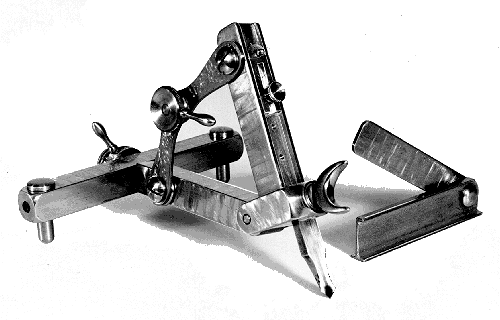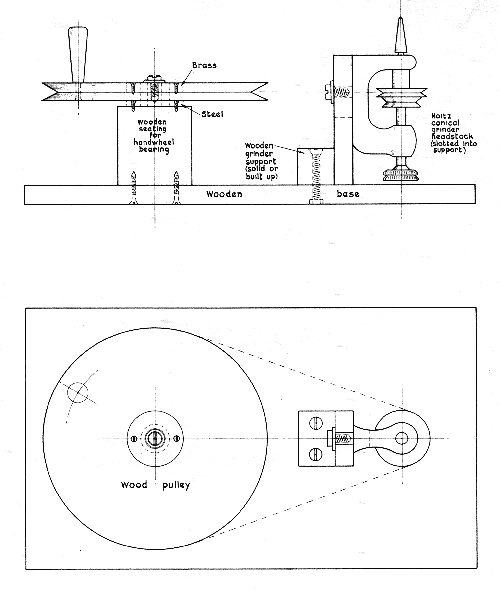Here’s an old article dealing with the sharpening of ornamental turning cutting tools:
Introduction
Ideal brilliance of cutting in ornamental turning depends entirely upon the excellence of the sharpness of the cutter, and also upon the speed at which the work is rotated.
Tools Required
The tool requires not only to be sharp, but also to have its facets flat and polished.
The Goneostat
A suitable goneostat is needed to hold the tool so that the sharpened edge is formed by facets which are perfect planes.
As made by the trade, the goneostat is usually too bulky to hold in the hand.
There is also a further disadvantage in that the facet on which it rests are so close together that it is difficult to prevent tipping to the detriment of the edge required.
The horizontal and vertical planes, as engraved on the instrument are true only when, as is seldom the case, the base of the instrument is parallel with the bench or board on which the sharpening is being done.
The purpose of these angles is that tools marked with their angles have only to be inserted in the instrument, which is then set over to the corresponding angle and the sharpening process, in theory, takes place on the existing facet.
This, however, is very far from being a fact. In actual practice the goneostat is so far from accomplishing all that is expected from it, that the angles marked on the instrument can be safely disregarded.
Very little experience with the ordinary goneostat made this defect evident to the writer, and his reliance upon goneostats ceased in favor of adjustment of the tool facet to the sharpening stone or slab, by eye alone.
This demands experience and above all patience but so does everything else that is worth doing.

Here is a photograph of a simple goneostat which is stable and dependable in use, and far more comfortable to hold than the more elaborate type.
The writer has used this instrument for over 30 years, which in itself is ample testimony to the high regard he has for it.
But whatever type of goneostat is used, whether with or without the horizontal and vertical angles marked upon it, the user will have to set the tool to the stone, or plate, byvisual inspection.
It is not claimed that this is an exact method, but in actual practice it is more accurate than when the angles marked are relied upon solely.
Grinding Stone
In addition to the goneostat, a grinding-stone and a metal (brass) slab are necessary.
The slab, some 3″ square, and a trifle thicker, than the Arkansas stone is used with oilstone powder and oil (“Three-in-one”), in the first instance, followed by the Arkansas stone and paraffin.
The need for a slight variation in the respective thicknesses of the two sharpening appliances is that the edge of the tool, which is,-the important part is certain to bear upon the polishing and sharpening stone.
The Arkansas stone will be found amply sufficient to finish the tools upon, as it both sharpens and polishes.
Magnifying Glass
Human eyesight however good isn’t sufficient to ascertain the state of the cutting edges of fine tools, and a really powerful magnifying glass is necessary to make sure that the tool facet is a perfectly plane surface right up to the cutting edge.
The oilstone powder and oil used on the brass plate very soon renovate the worn edge of the tool.
When this has been done (seen through the magnifying glass) the tool may be wiped clean of oil and powder, and transferred to the Arkansas stone on which a few drops of paraffin are placed.
On this the tool edge is brought to a condition which will give a satisfactory result.
As the Arkansas stone both sharpens and polishes the facet of the tool cutting edge, the need for further polishing on a separate plate can be disregarded.
Perfectly prepared tools can be ensured only by strict attention to the foregoing, and to one other requirements which as afar as the writer is aware, has not been mentioned in any book bearing on the subject of turning.
This is the need to make sure that not only are the sharpened bevels polished facets, but also that the top or nose of the tool which together with the bevels forms the cutting edge, is also in a perfect plane.
If it is not, if it has what maybe termed a comb-like edge, then striae or marks will be left on the work.
For this reason the top must be stoned without tilting the tool to ensure the maximum satisfactory result. Slide-rest tools which move laterally, have not the same need for care in sharpening as is essential for the revolving cutters.
All this may seem to entail unnecessary work, but first-rate cutting depends upon tools in first-rate condition, and the information given above, faithfully followed, will ensure that they are.
There is yet one more counsel of perfection which must be offered.
It is that whether the tool is in the goneostat or is held in the hand while reducing the top to a plane surface, the pressure on the tool point should be impartee as it is moved away from the operator, and released as it is brought back.
The reason for this is to safeguard against the formation of a “wire edge”.
This, however minute, even if it can only be seen under a magnifying glass is completely detrimental to perfection of cutting.
It may usually be avoided or prevented by adopting the above method, i.e. pressing the tool on the stone only on the forward stroke.
The operator who visualizes the why and wherefore of the method commended, and finds that the taking of adequate pains really does give enhanced results is handsome repaid for his time and trouble, finding that the patterns and forms cut with the revolving cutters really are most brilliant, thanks to the scrupulous care lavished upon the preparation of the tools.
Sharpening Bead Tools
The standard conventional equipment sold for sharpening bead tools has little to commend it.
Any work which demands the removal of the work and the slide-rest during a job before a tool can be sharpened, is ill-adapted to the turner’s needs, so much so that one marvels how such an awkward piece of equipment could have been designed by anybody with any practical experience of lathe work.
The standard outfit sold for sharpening bead tools necessitates a cone pulley being placed on the mandrel to drive a miniature lathe-head carrying the grind stones, held in the hand-rest obviously the work in hand must be removed from the lathe, with the certainty that it will not, on being returned to the mandrel, re-assume its previous position, and therefore all subsequent cutting will be out of truth in relation to the work previously executed.
The slide-rest, too, on being moved and then put back for further operations, will be likely to cause further inaccuracies.
On top of this, the apparatus is intended when in use to be driven in one direction only, whereas such a procedure means that pressure is applied to one side of the cone, to the detriment of the truth of the bead tool.
It is essential that:
- the instrument shall be independent of the lathe
- that it is so made that the revolution of the cone can be conveniently reversed. When the cone has revolved a number of times, it should be possible to drive it in the opposite direction for a similar number of revolutions. Otherwise the total will be ground on one side only, soon to become useless.

The sketch shows a most effective arrangement for grinding these tools. In use the handwheel is revolving first in one, then in the other direction.
The large wheel coupled by a flexible leather, belt to the small pulley, gives the necessary. slow speed to the cone.
The latter, it will be noticed, is in a vertical instead of a horizontal position, and this again removes an inconvenience inherent in the standard machines, as the tool under this arrangement is much more conveniently held to the cone.
This arrangement has stood a very long test, and it is recommended without reserve to all who seek maximum efficiency.
At this point one might say that although lathe-makers “ought to know”, they don’t always, and their products must be judged in the light of actual experience, and not in their pious aspirations.
As the cone is vertical the grinding paste should be thicker than normal, and oilstone powder mixed with Vaseline will meet this requirement..
The writer firmly refutes the assertion that the ircn cones are necessary for the final polishing of the convex curves.
The brass cones impart a polish which has been found to be perfectly satisfactory in every way.

